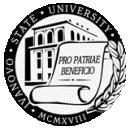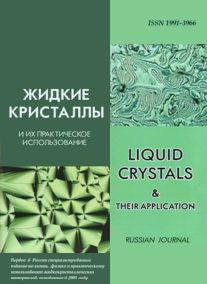|

|
Liquid Crystals and their Application
Russian Journal Zhidkie kristally i ikh prakticheskoe ispol'zovanie Жидкие кристаллы и их практическое использование |

|
|

|

|
|
|
Menu

|
|
|
|
|
Zhidk. krist. ikh prakt. ispol'z. = Liq. Cryst. and their Appl., 2015, 15 (3), 109—118.
DOI: 10.18083/LCAppl.2015.3.109 |

|
|
Carbon Nanotubes Modification of the Conductive ITO-Layer for Orientation of Liquid Crystals Used in Electro-Optical Devices for Information Processing
|
N. V. Kamanina1,2, A. A. Kukharchik1,2, P. V. Kuzhakov1, Yu. A. Zubtcova1,
R. O. Stepanov3, N. V. Baryshnikov3
|
Author affiliations
1Vavilov State Optical Institute, Laboratory for Photophysics of Media with Nanoobjects,
5 Cadet Line V.O., Bld. 2, St. Petersburg, 199053, Russia
E-mail: nvkamanina@mail.ru
2St. Petersburg Electrotechnical University (LETI),
5 Prof. Popov St., St. Petersburg, 197376, Russia
3N. E. Bauman Moscow State Technical University,
Scientific Research Institute of Radioelectronics and Laser Technology,
5 2nd Baumanskaya St., Bld. 1, Moscow, 105005, Russia
E-mail: stepanovr@bmstu.ru;
E-mail: baryshnikov@bmstu.ru
|
|
Abstract
One of the important problems saving the functional properties of the liquid crystal (LC) electro-optical spatial light modulators, LC-cells and the analogs of display elements is availability of the qualitative conducting layers that withstand certain levels of applied voltages and light loadings. The mechanical hardness, laser strength, refractive and spectral parameters of the ITO-conducting coating layers structured by carbon nanotubes (CNTs) have been studied. These CNTs have been deposited using contactless laser technique under varying the electric field. Some computational and experimental alternative arguments have been performed in favor of singe-walled CNT usage and the conclusions about the benefits of the structured ITO-coatings as a conducting and orienting layer for alignment of LC-molecules have been made.
Keywords: liquid crystals, interface, surface relief, ITO-coating, carbon nanotubes, laser deposition technique, penetration, hardness, surface electromagnetic waves, spectrum
|
|
|
|
|
|




